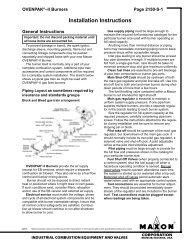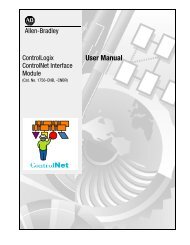E110 FIREYE FLAME-MONITOR™ - Westmill Industries
E110 FIREYE FLAME-MONITOR™ - Westmill Industries
E110 FIREYE FLAME-MONITOR™ - Westmill Industries
Create successful ePaper yourself
Turn your PDF publications into a flip-book with our unique Google optimized e-Paper software.
42<br />
Type 69ND1 Flame Rod<br />
The flame rod and its insulator should be kept clean by washing routinely with soap and water. Rods<br />
should be routinely replaced as they oxidize.<br />
Flame Signal Strength<br />
Routine observation of the flame signal strength will forewarn any deterioration in the capability of<br />
the flame detector or its application.<br />
Contacts<br />
There are no accessible contacts in the Flame-Monitor. Where contacts are used, their design assures<br />
long trouble-free life when the load circuits are maintained within the published load ratings.<br />
Electrical Noise<br />
In areas of excessive electrical noise, the installation of an electrical noise suppressor (P/N 60-2333)<br />
to the power supply at the control circuit may be helpful.<br />
Humidity<br />
In areas of high humidity, the control chassis should be removed and placed in a dry atmosphere<br />
when the system is expected to be out of service for an extended period.<br />
Periodic Safety Check<br />
It is recommended that a procedure be established to test the complete flame safeguard system at<br />
least once a month,. This test should verify the proper operation of all limit switches and safety interlocks<br />
as well as flame failure protection and fuel safety shutoff valve tightness.<br />
Rotation<br />
It is recommended that control and scanner units purchased as spares be installed periodically to<br />
ensure proper operation.<br />
®




